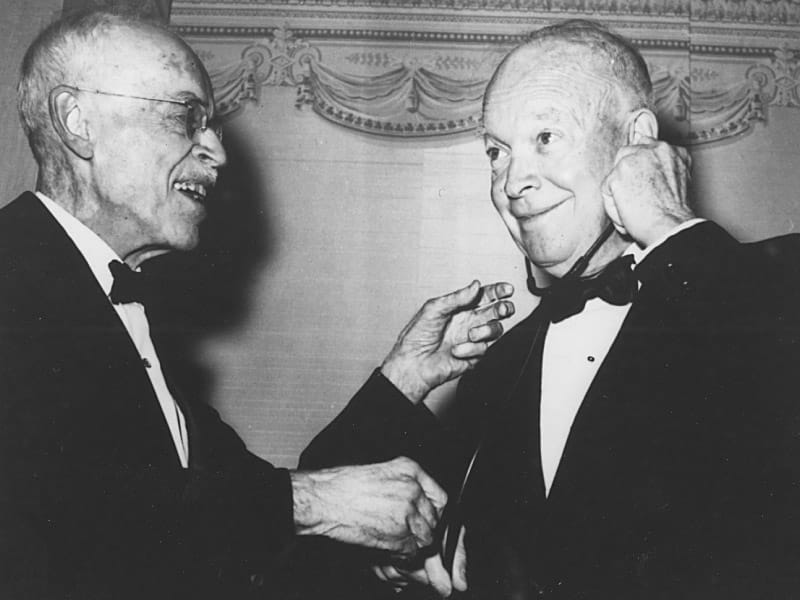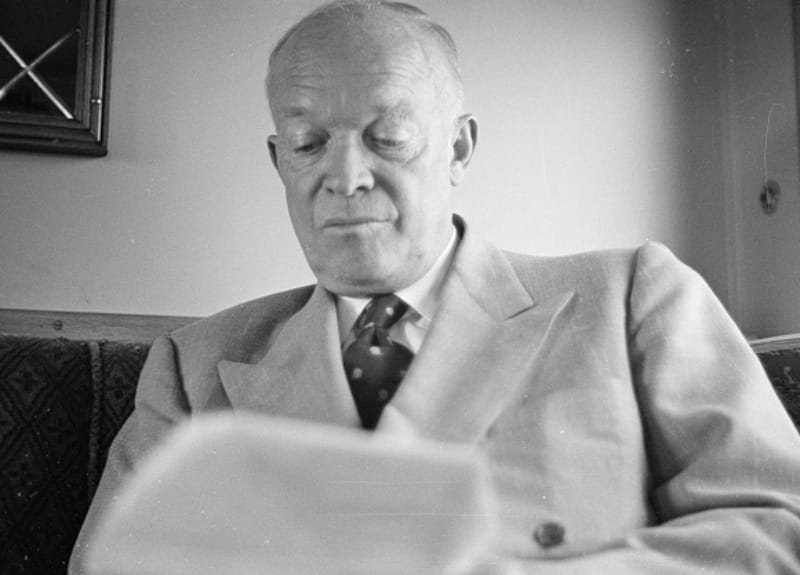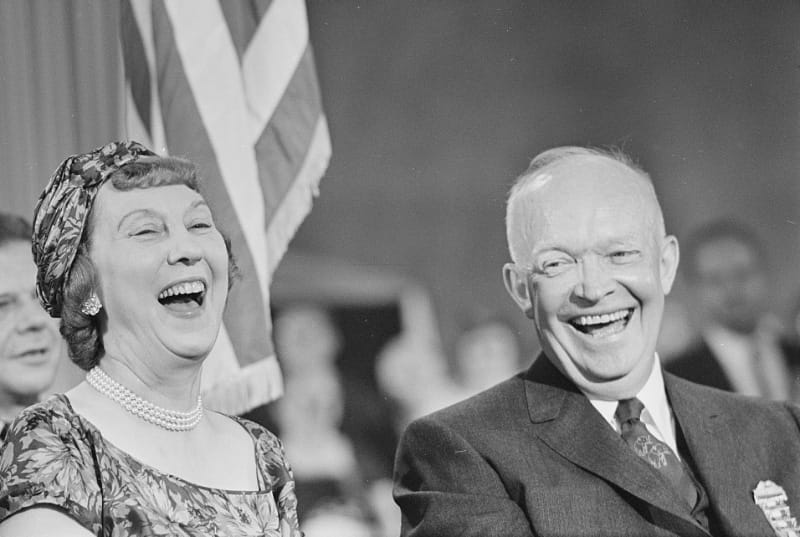The presidential heart attack that changed America
By Michael Merschel, American Heart Association News

Heart disease is no stranger to the White House.
But in a century of presidential cardiac crises, none affected America the way Dwight Eisenhower's 1955 heart attack did. The incident first shocked, then enlightened the nation. And coming right before an era of rapid scientific progress, it highlights how much researchers have learned about heart health.
The list of presidents with cardiovascular problems in the past 100 years is almost as long as the list of presidents. Franklin D. Roosevelt died of a stroke at age 63 while in office. Calvin Coolidge died of a heart attack at age 60, four years after leaving the Oval Office. Lyndon Johnson had a heart attack before he ascended to the White House and died of one at age 64 after he left.
At 66, George H.W. Bush was treated for atrial fibrillation, a type of irregular heartbeat, while in office. After leaving office, Bill Clinton needed quadruple coronary artery bypass surgery in 2004 at age 58 and a stent procedure in 2010.
That's just a sampling. Eisenhower's heart attack stands out in part because it happened during an era when people were paying more attention to cardiovascular disease, but even doctors knew strikingly little about it.
"The very phrase 'risk factor' didn't exist," said Dr. Thomas H. Lee, chief medical officer at the consulting firm Press Ganey. "So the idea that you could predict who was at risk didn't exist."
Lee, who wrote about Eisenhower's case for the New England Journal of Medicine in 2020, said heart attacks at the time "came out of nowhere, and they were terrible." Even for those who made it to the hospital, the death rate was as high as 40%.
Eisenhower's case began on a golf course in Denver on the afternoon of Friday, Sept. 23, 1955. The World War II hero, who had been elected in 1952, complained of indigestion. He blamed the discomfort on his lunch, a hamburger with Bermuda onions.
But shortly after midnight, he woke up with severe chest pain. His wife, Mamie, summoned his personal physician, who arrived at 3 a.m. Exactly what care the president received next is debated, but it's likely the main attempt at treatment at that point was to simply give him morphine for his pain. It wasn't until the next afternoon that an electrocardiograph was brought in to measure his heart's electrical activity.
It was only after Eisenhower awoke at 1 p.m. that the device was used to confirm he'd had a significant heart attack.
"When you look back at his care at that time, it's really remarkable how different it is from now," said Dr. Adrian Messerli, section chief of interventional cardiology at the University of Kentucky in Lexington. Messerli co-wrote a NEJM article about Eisenhower's heart attack on its 50th anniversary.
Messerli said the slow pace of the president's care contrasts with what would be done today. Time is now known to be of the essence, which is why 911 should be called immediately when people experience heart attack symptoms. A patient would be rushed to the hospital, examined immediately with an ECG and sent to the catheterization lab for a procedure to clear any blocked arteries.
Almost none of that was possible in 1955.
Coronary care units did not exist. Neither did CPR or portable defibrillators for people who went into cardiac arrest. Those all came along a few years later, said Lee, who also is a senior physician at Boston's Brigham and Women's Hospital.
"Good care was you put people to bed, and you hoped for the best," he said.

The lack of effective care made news about a presidential heart attack terrifying. The then-U.S. surgeon general, Dr. Leonard Scheele, equated his shock to what he felt after Pearl Harbor was attacked. On the Monday after the news broke, the Dow Jones Industrial Average fell 6% – a $14 billion loss that was the largest since the stock market crash of 1929.
Into this fearful atmosphere stepped Dr. Paul Dudley White of Boston's Massachusetts General Hospital. He had been summoned by military doctors and flown to Denver on Sunday.
White, who had helped found the American Heart Association in 1924 and had treated the likes of Andrew Carnegie and William Randolph Hearst, was "arguably the most respected physician in the country," Lee wrote.
Eisenhower had cleared the way for an unprecedented public discussion of his health by ordering his press secretary to "tell them everything." White reviewed the president's records, consulted with his doctors and examined the man.
And before a packed news conference on Monday morning, White seized the moment not simply to discuss the president's prognosis, but to teach.
"Heart attacks became less mysterious and less frightening to millions of Americans that day," Lee wrote, "and White gave them the message that they could take steps to reduce their risk."
White explained that the president's problem was not related to golf or Denver's high altitude, as some suspected. He spelled out the process of what he called "coronary thrombosis," where a clot prevents blood from flowing to the heart.
Speaking from the frontiers of understanding, White said that heart attacks might be related to factors such as diet, alcohol, tobacco, exercise and family history.
Crucially, Lee said, White also provided honest hope about the president's chances for recovery. Also crucially, White said a heart attack did not mean the end of a productive life, as many thought at the time.
The nation listened. As Clarence G. Lasby wrote in his 1997 book "Eisenhower's Heart Attack: How Ike Beat Heart Disease and Held on to the Presidency," White had gone to Denver as a consultant; a few weeks later, he was a national celebrity.
White's thoughts on heart health became front-page news. Lasby quotes him as saying, "I talked to the country during those next few weeks as I had talked to families of many private patients."
The immediate effect was to dispel the notion that heart attack survivors were doomed to lives of inactivity. Over time, Messerli said, White's message also "may have improved the public's tolerance for financing cardiovascular research and medical research generally."
White's accomplishments did not necessarily include healing the president.
"I think that he survived despite the care," Messerli said. "That is, it is very unlikely that any of the medical therapy that he received at the time did much to influence the outcome of his heart attack."
Eisenhower, however, did recover and won re-election in 1956. And on his own, he took several steps to help his heart health that doctors would recommend today.

Lasby writes that Eisenhower was "far ahead of the field" in following White's advice on the importance of exercise and a low-fat, low-cholesterol diet. The former four-pack-a-day smoker had quit cold turkey in 1949. He carefully watched his weight. And after the president read about a cholesterol-lowering diet in 1959, a doctor joked that he became more worried about his cholesterol levels than his golf score.
His cardiovascular problems did not end, though. Eisenhower had a stroke in 1957 that affected his ability to speak. Another heart attack in 1965 ended his participation in public affairs. He died of congestive heart failure in 1969 at the age of 78.
Eisenhower did live long enough to benefit from the wave of treatments that were being developed in his final years, Messerli said. He was one of the first to benefit from a defibrillator – which can shock a heart into proper rhythm – that was introduced in 1962. On one hospital stay in 1968, Eisenhower was shocked multiple times. "Every time that was administered, it could be argued that it saved his life," Messerli said.
Late in his life he was considered for other then-new treatments, including coronary bypass surgery.
Heart attack treatment would enter a new era when balloon angioplasty – where a balloon is inserted via catheter to open blocked arteries – was successfully pioneered in 1977. Such treatments, plus the arrival of clot-dissolving drugs in the 1980s, means that today, the 30-day survival rate for someone having even a severe heart attack is about 90%.
Looking back at such progress, Messerli said, makes him excited about today's emerging technologies. "It's humbling to think about where we'll be in another 80 years, with appropriate research and funding."
White is known today for educating people about heart health with kindness and compassion, but Eisenhower's feelings toward White cooled because of what he perceived as "publicity seeking," Lasby writes. But the author credits the president and the physician for helping to unleash "an unparalleled flood of knowledge that constituted the nation's first serious inquiry into its most devastating disease."
Writing the president in 1955, the editor of U.S. News and World Report noted the many requests for reprints of its interviews with heart experts and said, "Because of your illness, the American people are better educated on the heart and its ailments than they ever have been before."
And Army Dr. Thomas Mattingly, who oversaw much of the president's treatment, wrote of White, who died in 1973 at age 87, "Every surviving victim of coronary disease today is indebted to him for his help."





